Maybe the cold rains of May relented for a day or two before the warm deluge of June set in. The muddy Juniata raged and roared, stuff of my oldest nightmares, eventually claiming a 63-year-old woman, fished lifeless from the Plummer’s Hollow bridge on the month’s first Sunday night. Back behind the bridge, terra nullius reverts to pathless jungle, charred vestiges of the unhoused surrendering quickly to invasives, while the sitting-place and trails carved for unholy trysts have been all but obliterated by woodcutters and a terrifying derecho. On the occasional sunny day, the 17-year-cicada horde whines and screams. I shut my eyes and imagine I’m back in the tropics.
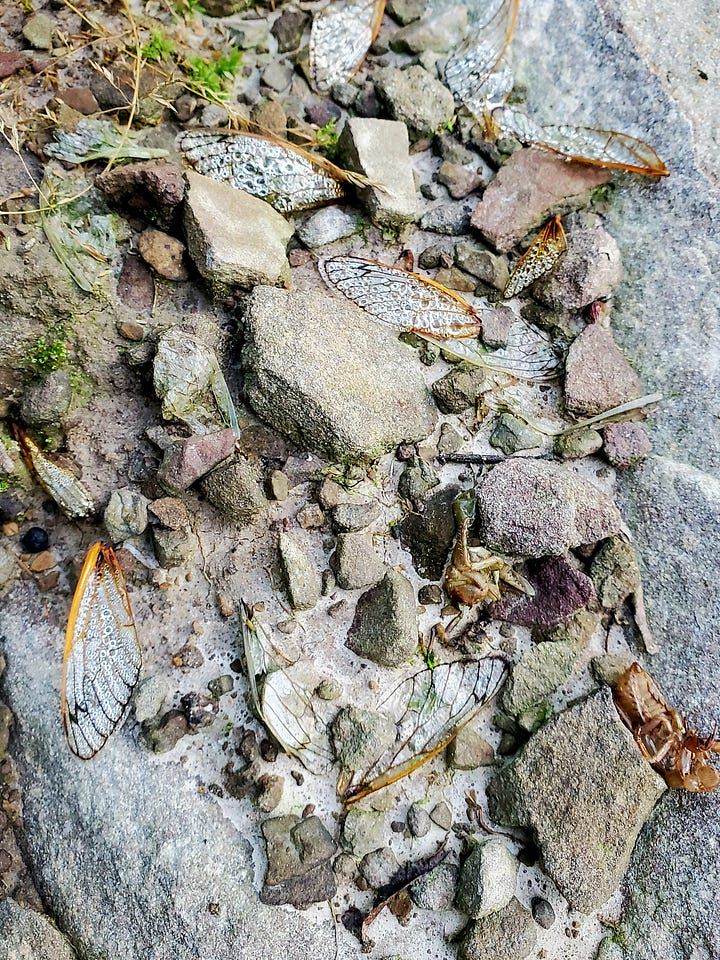
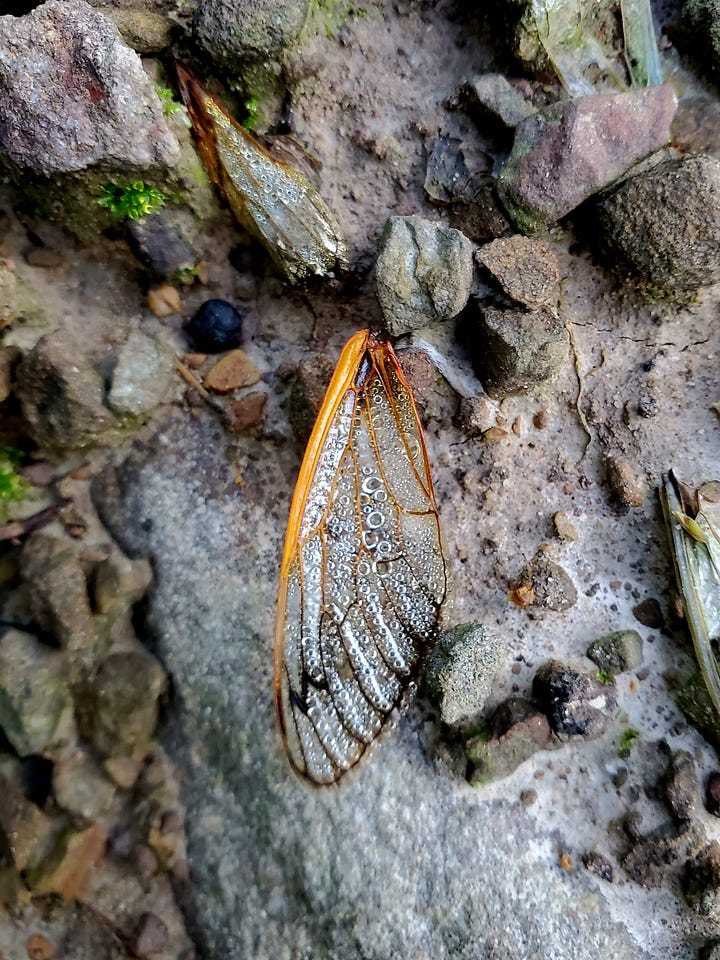
The stream of northward migrants slowed to a nocturnal trickle that ended with a final Swainson’s Thrush at 10:49 PM on the 12th. As the month continued, the local nighttime songsters began to quiet down as well—the cuckoos have all but stopped, while the Ovenbirds and even the Field Sparrows and Eastern Whip-poor-wills sound a bit less desperate now, as families of Barred Owls caterwaul in increasingly terrifying cadences. Off and on through the night, Eastern Towhees, Song Sparrows, Chipping Sparrows, Indigo Buntings, Common Yellowthroats, Red-eyed Vireos, Great Crested Flycatchers, Acadian Flycatchers, and Eastern Wood-Pewees wake up to sing. Once in a while, a Killdeer from nearby Sinking Valley fields flies over the mountain in the depths of the night, and as dawn approaches, a Green Heron sometimes squawks once or twice as it crosses over.
Dusk wraps up by a bit after 9 with the last Eastern Phoebes, Wood Thrushes, and towhees, and starts up again by 4 in the field and 4:30 in the woods, invariably signaled by a Northern Cardinal, with Purple Martins some of the earliest vocalists, up from Sinking Valley homes for their pre-dawn bug feast over the field.
Balcony mornings end before 6 AM, as the chorus has already died down by then. The earliest breeders are already flocking—Rock Pigeon commuter numbers have rebounded with the addition of new family members, while European Starlings are swirling about, ceaselessly coming and going from the mountains and the valleys into town, bringing repast to second broods. They’re flocking in the hundreds, something I can’t remember from previous Junes. Maybe they’re growing fat on all the cicadas.
Passing 200
When last I wrote, on May 16, the year list stood at 196, poised to break 200 well before previous years, in large part owing to an excellent waterfowl season. The rarities continued to trickle in with a couple more May nights of decent northward movement: Semipalmated Plover and Alder Flycatcher on the 16th, then Lesser Yellowlegs and the second-ever (and first spring) Black-bellied Plover on the 21st, putting us over 200.
By the 20th, the balcony noise was mostly predictable, except for a Northern Waterthrush which stuck around for a few days, singing its heart out along the banks of Bald Eagle Creek:
At one point, two of them showed up. This happened during a temperature plunge into the 30s—a distant memory now as we head toward the 90s. For a bit, it almost seemed as if the waterthrush would stick around to breed, but like other oddities at the long, drawn-out tail end of spring migration, it eventually gave up and moved on. By the last week of May, I expected little other than Swainson’s Thrushes and Blackpoll Warblers as barely visible diurnal migrants; the hidden ebb of the migration would continue for weeks, but only detectable at night.
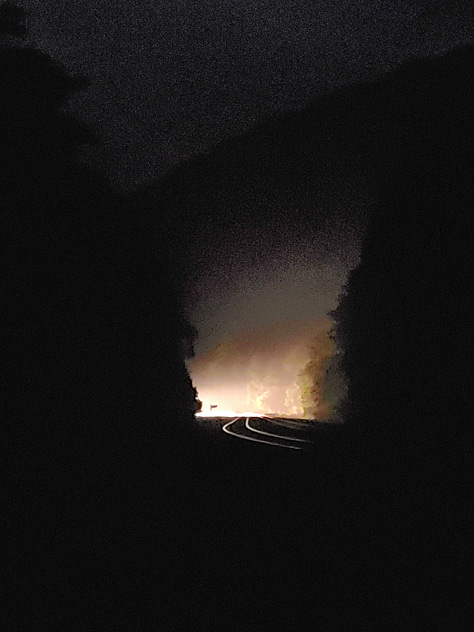
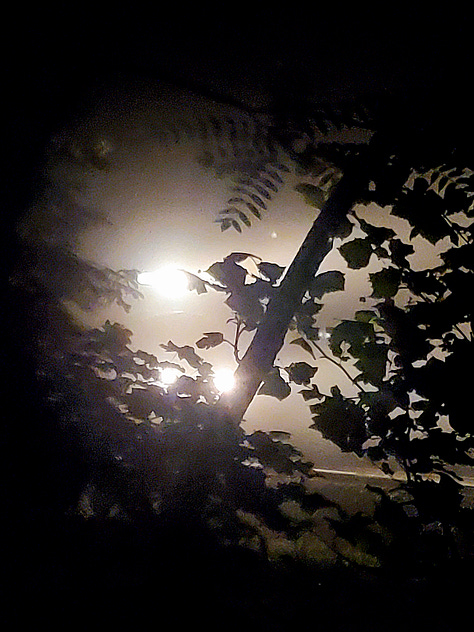
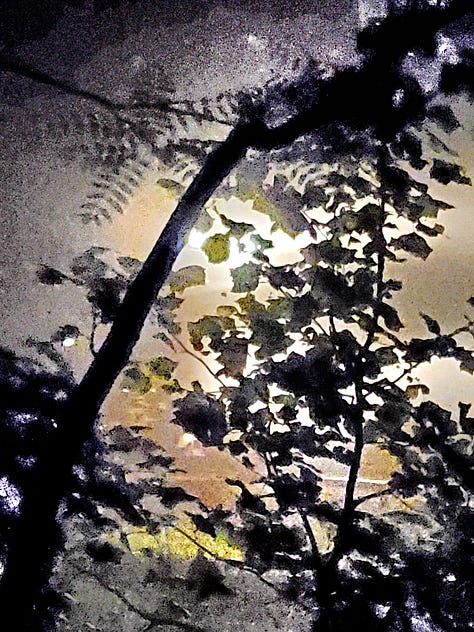
Nevertheless, because one never knows, I grabbed a beautiful Sunday on June 1st to get the month off on the right foot. First off, I was dive-bombed in the darkness by a catbird along the tracks; in its rage, it parted the few hairs I have left on my scalp.
At the crossing, I listened for the locals to wake up, attuned to anything unusual that could signal a new or uncommon breeder such as a Kentucky Warbler (I had last heard one from the balcony on May 29th, which was awfully late for a migrant.) Instead of the Kentucky’s ringing song, I was rewarded by the blurry notes of a Mourning Warbler from a streamside box-elder thicket, the first-ever for June, but definitely not one to stick around and breed. I recorded a bit of its song until a train came, after which it hushed.
Taking this as a good sign, I mustered the strength for a knife-edge trek up past Warbler Knob to Grosbeak Trail. At every hollow and gully, a pair of Hooded Warblers sang and distracted, and there more American Redstarts than I can ever remember—50 for the day, leaving me with an acute case of warbler buzz.
The weather was clear, windy, and cool, seemingly not a day for migrants, but the surprises continued. I paused by the thickets along Bird Count trail in the middle of the territory of an extremely agitated Brown Thrasher family.
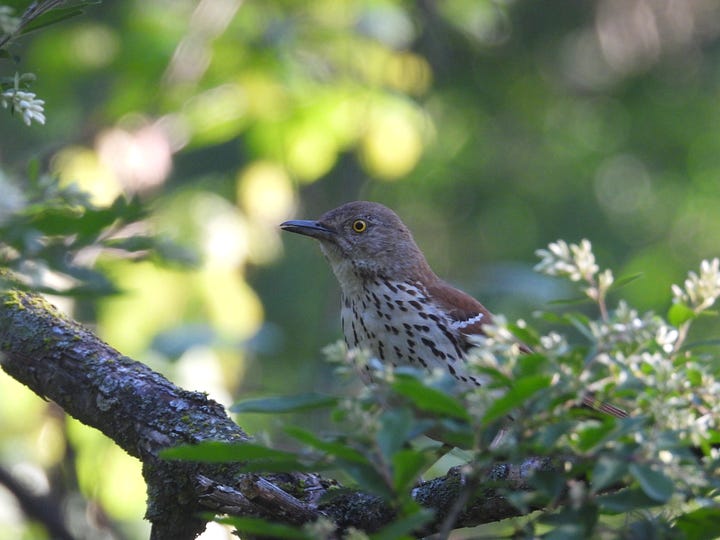
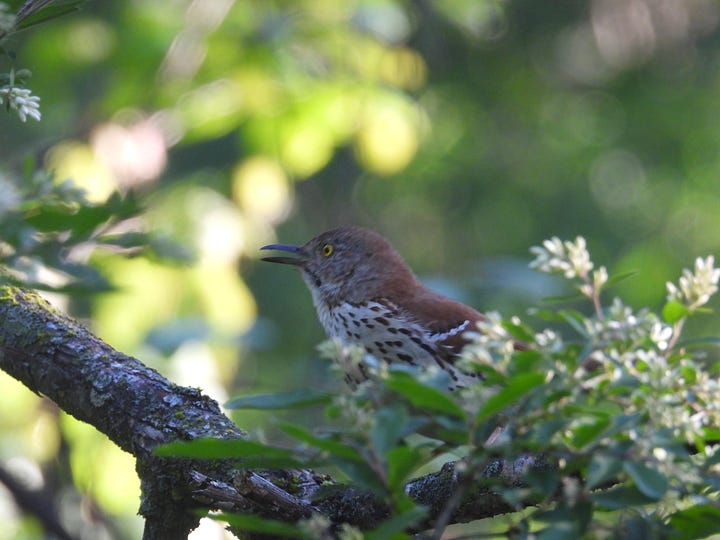
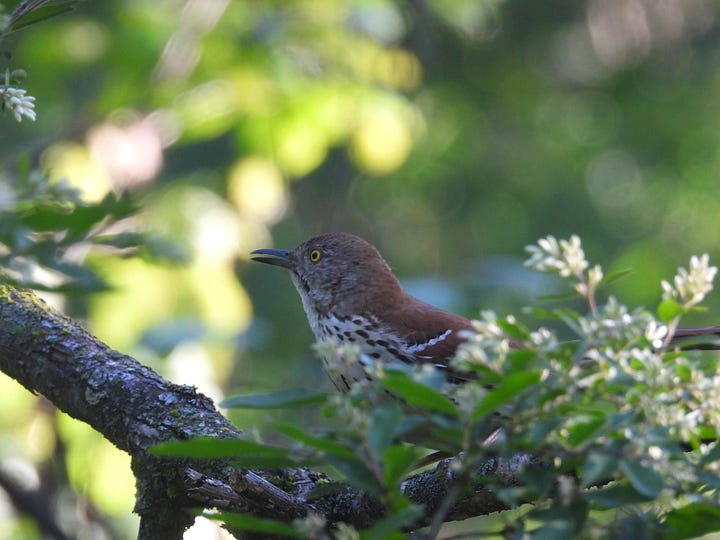
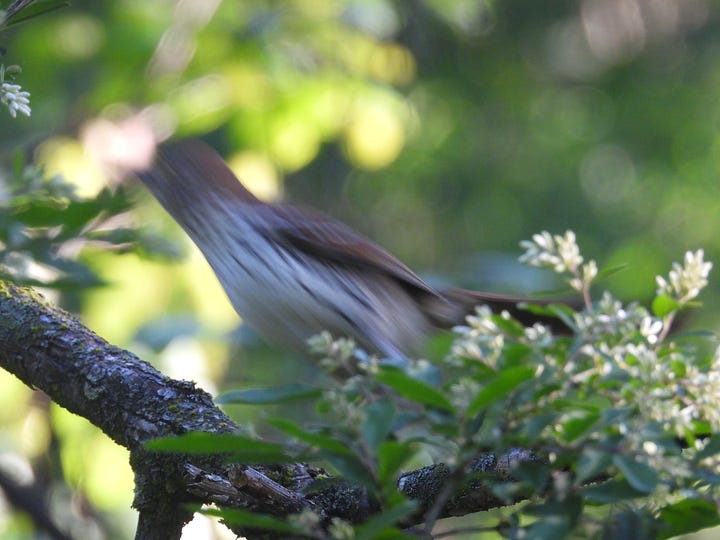
As other birds showed up to check me out, a three-note song issued from somewhere in the canopy, taking several seconds to register in my brain among the cacophony of the regulars. Quick THREE BEERS! - an Olive-sided Flycatcher, only the fourth of my lifetime (all in Plummer’s Hollow). Today, I had come prepared, camera slung around my neck. It had flown over my head and alighted, as its kind always does, on a snag, but first I needed to make sure that the flycatcher I was looking at was the right species. ID secured with binoculars, I glanced down once, then raised my camera up, but it was already gone, a cardinal in its place. Two or maybe three songs, and a split-second glance, was all I got of a species that turns up in Plummer’s Hollow about once every five years.
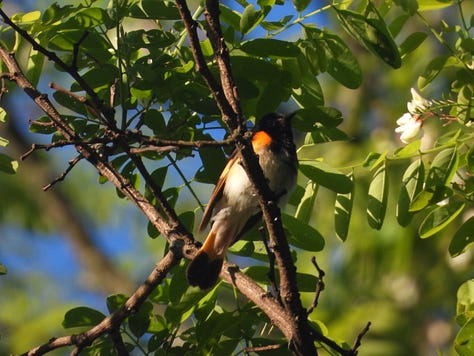
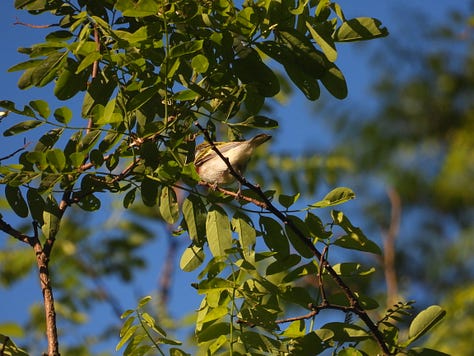
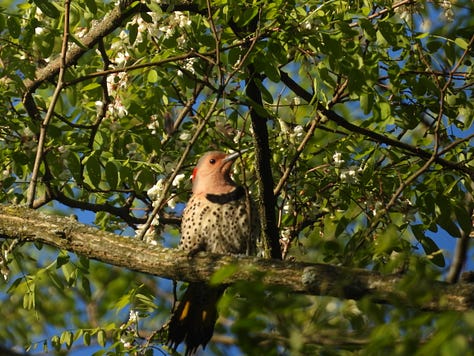
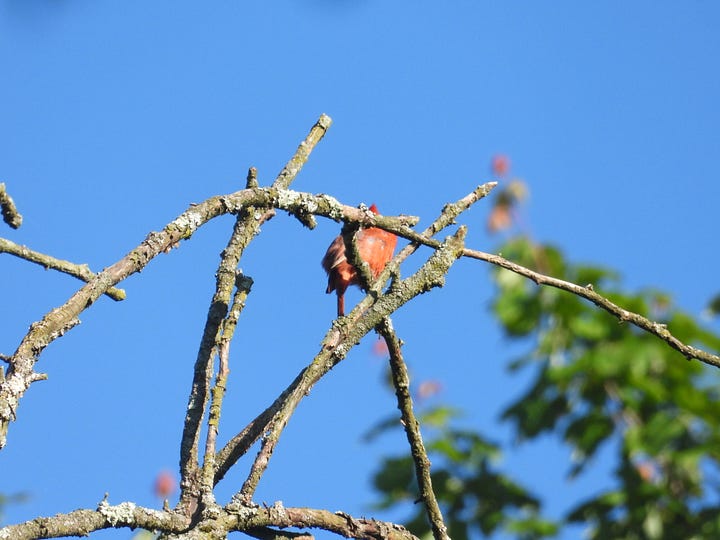
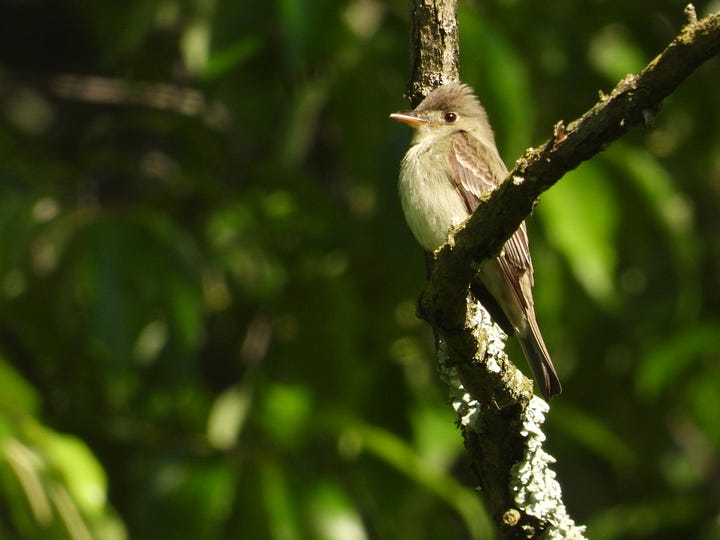
What was effectively the last visible migrant of the year came about an hour later. Chips from a blackberry thicket in First Field revealed a highly improbable female Wilson’s Warbler, a third first-ever June sighting for the day. I could almost feel the loneliness and desperation of the diminutive bird, delayed somewhere in the vastness between here and Latin America, with hundreds of miles left to go. It checked me out for a few seconds and then was gone.
In the spruce grove, there was no sign of Sharp-shinned Hawk nor of Golden-crowned Kinglet.
The last of the last
In the afternoon of that same Sunday, what could almost be classified as the first fall migrants were honking about. Thirty Canada Geese, in a V above the field, might seem like nothing out of the ordinary until you realize that this species is supposed to be nesting. Instead, this was likely a group of unsuccessful youngsters, maybe all males, that had failed to find suitable mates and were as a result roaming the land. This was the last of several flocks I saw, beginning in late May.
Meanwhile, the lasts piled up in the NFC register. First was a final Savannah Sparrow on May 30. Then, the early morning hours of June 3 brought a reasonably good diversity of migrants, including the last Yellow-bellied Flycatcher (and only NFC) and the year’s only Willow Flycatcher ( a rare miss in May). On the evening of that same day, the first-ever June Dickcissel; I wasn’t surprised when someone found one singing in a neighboring county not long after, as it seems that a few may stick around, though I can’t imagine they are successful, with most of their species far away from the Ridge-and-Valley during breeding season.
The expected June shorebird show was disappointing, except for the early morning hours of the 4th, when several flocks of Semipalmated Sandpipers twittered over. Yet another Least Bittern also flew by; we’ve had unusually high numbers of them this year, leading me to wonder just how rare this candidate for America’s Most Cryptic really is. That night ended up being the last big flight of Swainson’s Thrushes, and the last night for Gray-cheeked Thrush, which two years ago lasted into the second week of June. The thrushes were still falling as the first Purple Martins showed up around 4:30 AM.
On the fifth, a lone Hermit Thrush called in night flight. On the ninth, the stillness before 5 AM was interrupted by the calls of a Northern Rough-winged Swallow hunting over the field. Like the martins, this species only nests in the valleys, and this is the first time one has appeared in the June darkness.
With the passing of the afore-mentioned last-of-all Swainson’s Thrush, breeding became the only game around for a brief stretch until the southbound shorebirds begin to appear in early July, along with the molt-migrants and other confusing mid-summer movers, all eventually smothered by the katydids of August.
The loneliest Barn Swallow
The early breeders, from Common Ravens to Very Common Grackles, have all gone through the first cycle and some are well into their second broods. As a result, as every June, the greenery is bursting with youngsters. Some, like the House Finches, hang about their parents and continuing to beg as long as they’re tolerated. Grackleville is back, after being abandoned last year—grackle families tumble about the thick trees and shrubbery around the confluence, as raucous as always.
The rough-winged swallows didn’t breed close to the balcony this year, so I rarely saw any perching on the wires or resting in the parking lot. Nevertheless, by early June a family was about, some days hunting high, and other days skimming the river. Meanwhile, a single male Barn Swallow has stuck around, having apparently never found a mate. Every morning, it shows up, calling occasionally, hunting the air above the creek and the river. On the morning of the 11th, not long after 6 AM, it was doing its solitary rounds as usual when the rough-wing family showed up from downstream. The Barn Swallow joined them in flight, chittering loudly, to which they responded in kind, and then the five headed off upriver together.
This seemingly felicitous event was an unusual encounter for June--mostly what I see is grackles attacking crows and ravens, crows attacking ravens, and Chimney Swifts attacking all three, with the four species, and sometimes starlings, going after every Red-tailed Hawk they can find, and laying siege to the eagles.
Return of the Chat?
Though Plummer’s Hollow consistently records among the highest species numbers in the state for June, every year is slightly different, even among the breeding species. I did eventually spot a Sharp-shinned Hawk in the sky over Brush Mountain, so presumably it is nesting somewhere in the hotspot or a neighboring patch. One particularly birdy balcony morning saw a Merlin whizz by, suggesting that the species may be breeding somewhere nearby (last year, this rapidly-expanding species apparently had a nest over by the hospital). A Fish Crow showed up on a single day, Black Vultures a couple times, and a Belted Kingfisher only once, probably meaning that none are nesting anywhere nearby. Up on the mountain, I was quite excited by a Chestnut-sided Warbler singing on the powerline on June 3rd, as it’s been years since they’ve bred, but it doesn’t seem to have stuck around.
Missing altogether are the Orchard Oriole that sometimes nests along the tracks, Cliff Swallows that nest under the interstate, Wood Ducks, any sign of Red-shouldered Hawk, which has supposedly increased in numbers, and for the second year in a row, Broad-winged Hawk.
With missing species in mind, I set out today to do another sweep of the hotspot, in particular to find the elusive Black-throated Blue Warbler, proverbial needle in a haystack, with breeding pairs in 800 acres as few as one. The day did not begin auspiciously, as I first sprayed espresso all over the dining room thanks to neglecting the filter basket, and then forgot to screw my coffee thermos all the way on, resulting in backpack, chair, and floor soaked brown. Nevertheless, I persisted due to the rare dry high, reaching the breezy top of the powerline overlooking Sinking Valley by 6 AM, my arms a rash of gnat bites, a reward from the humid depths of the hollow.
And then I heard this:
The unmistakable refrain of a Yellow-breasted Chat issued from the scrub oak thicket—a month later than the one we had last year up in the field. This one showed no sign of letting up. I moved a few hundred feet off the top, and heard another, possibly indicating two breeding territories. This was extraordinary, as it is extremely good evidence for breeding of a species that hadn’t shown itself at all for decades prior to last year. I have to wonder if the power company’s neglect of the scrub oak, allowing it to grow up higher than I’ve seen in a while, has encouraged this repopulation.
I continued along the edge of the hotspot, struggling through thick jungles of privet, barberry, and rose, blessedly free of ticks. I’m probably still being discussed by the catbirds, as they seemed to like attacking me en masse. Summer birds we don’t hear at all up top, or along the tracks or river for the matter, included Yellow Warblers, Eastern Bluebirds, and a distant Eastern Meadowlark, as well as a couple Northern Mockingbirds.
I emerged from the jungle just as two giant shapes coasted by over a field, not far off the ground, maybe 100 yards away, the sun lighting the undersides of their wings. I lifted my binoculars in time to watch a pair of Sandhill Cranes disappear from view, then reappear briefly seconds later. Cranes are new for the hotspot; they wander widely east this time of year, with breeding grounds as close as northwestern Pennsylvania. I had been half-expecting to see them, as they’ve been popping up in nearby counties recently. I would guess they’re hanging around the flooded fields, an unusual feature of this nearly tropical rainy season.
Hours later, I stopped back by the powerline, and one of the chats was still at it, a few feet from me but characteristically invisible. No Black-throated Blue Warbler, but I’m not complaining.
Plummer’s Hollow has recorded 103 species for the month, a close second to Middle Creek WMA. For the year, we are already at 204, and are likely to surpass 210 species at this rate. Overall, we are ranked around #40 in the state, tied with Middle Creek, with around 234 species showing and 237 or so in total.

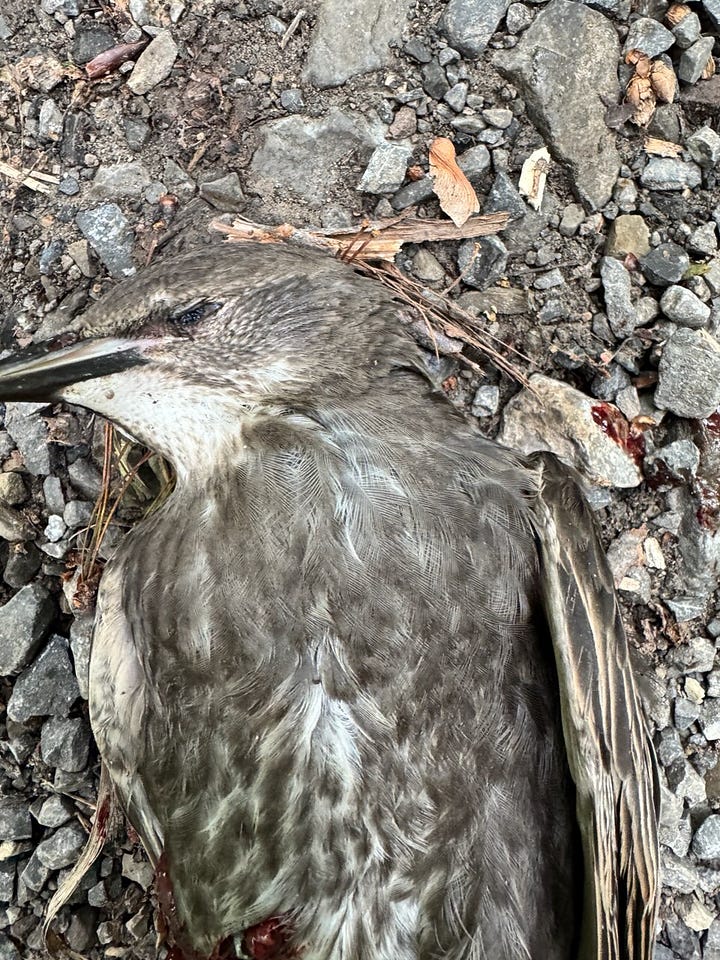

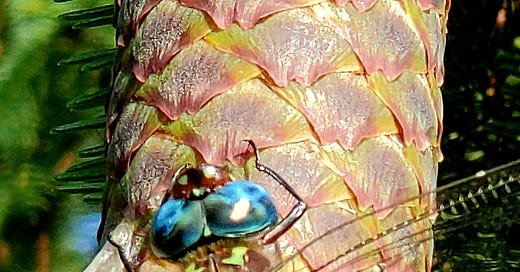



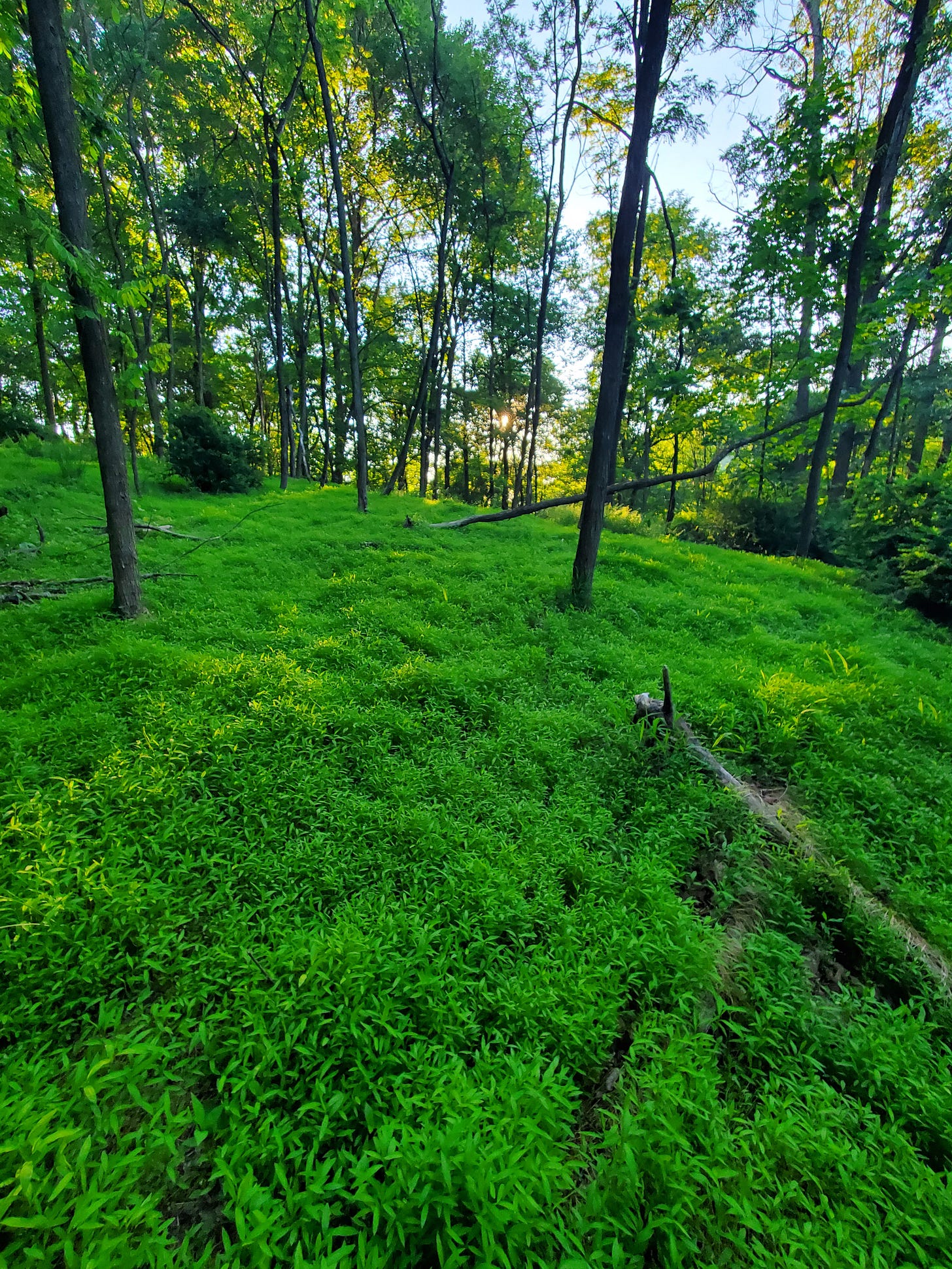
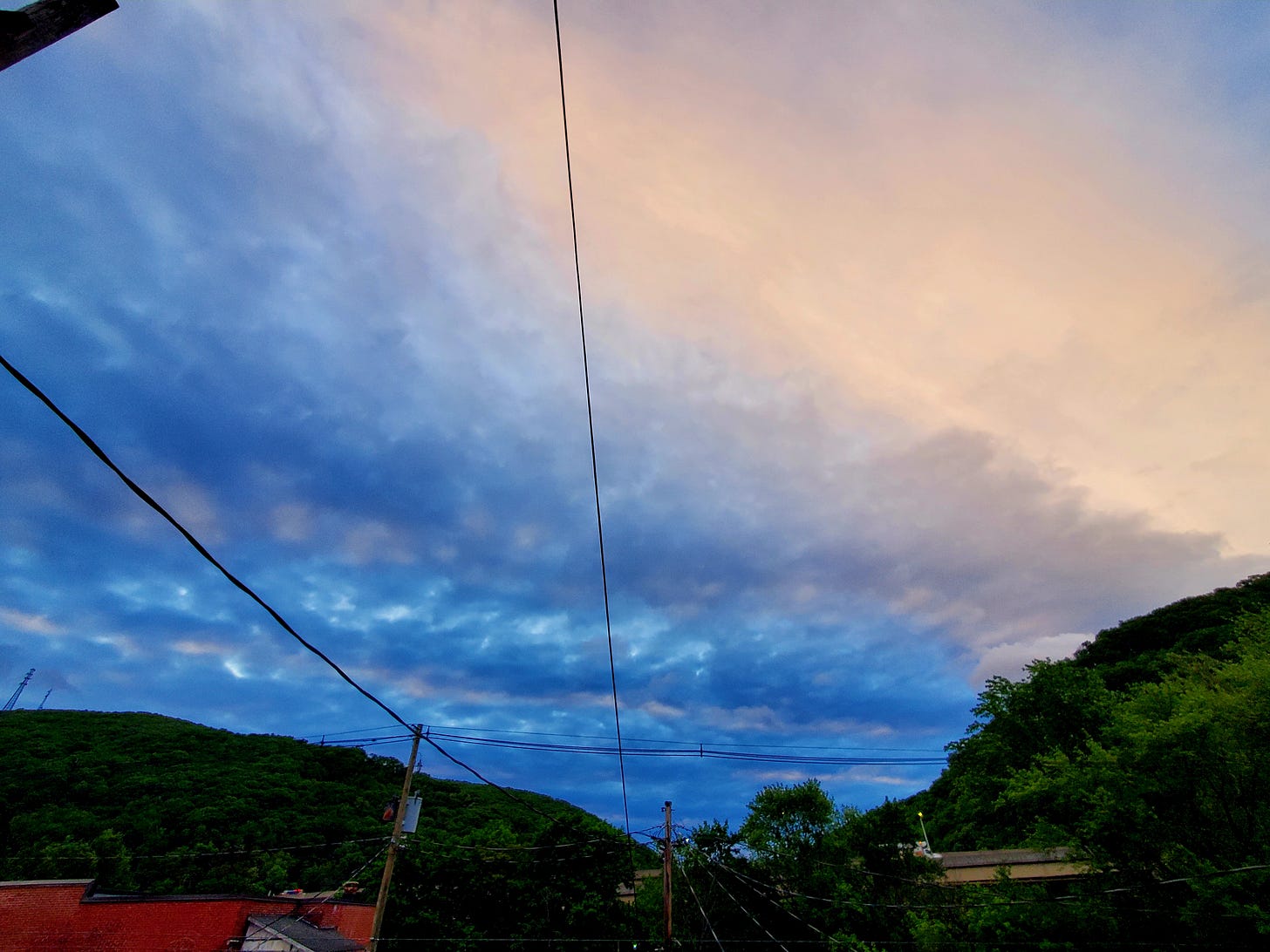
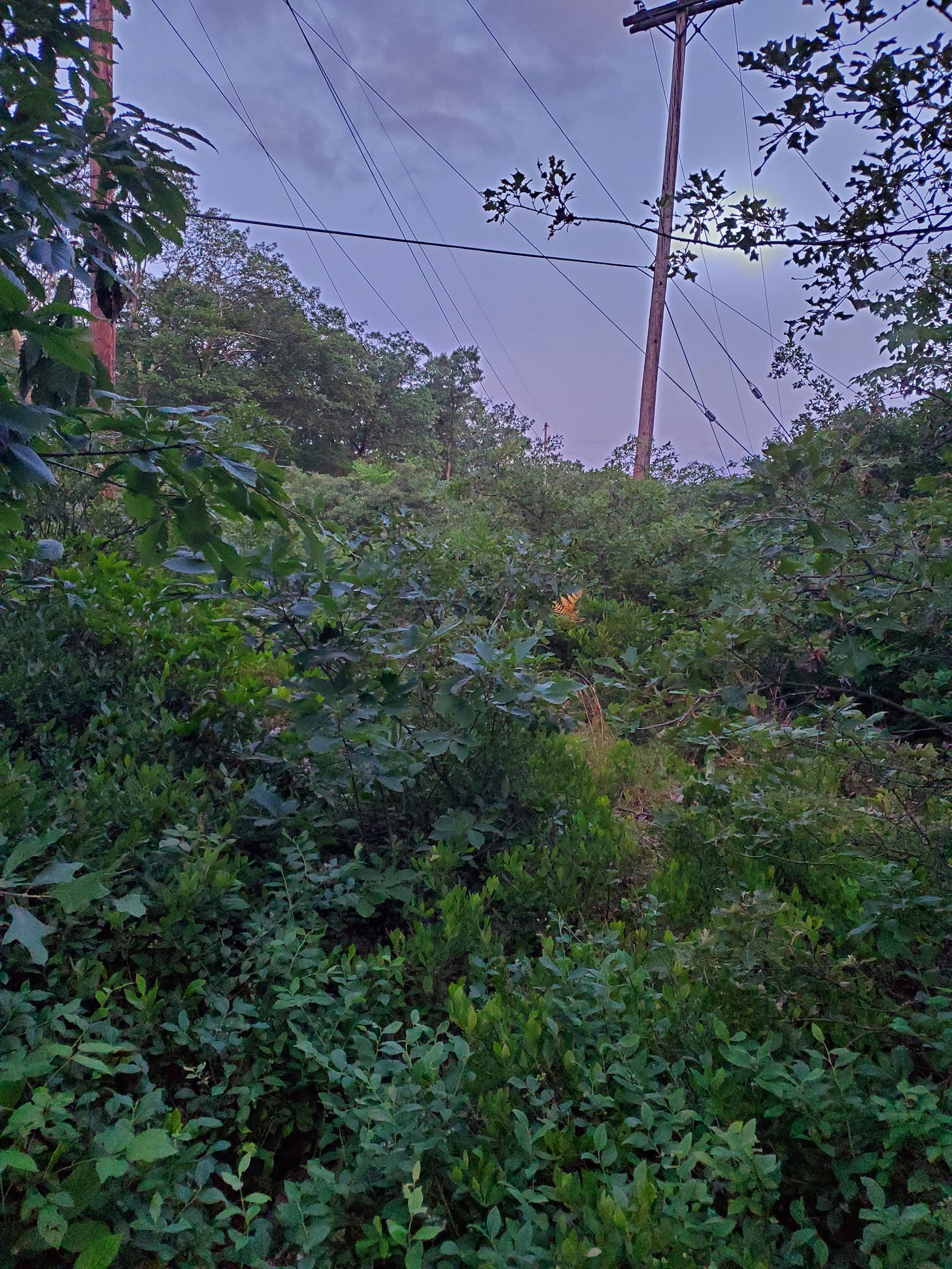
Definitely - it's a common nesting species, in yards as well as woods. If you listen to it very carefully, you'll sometimes hear it do very squeaky mimics of other species.
My Merlin app has been consistently recording a Blue Gray Gnatcatcher in my yard. I caught a glimpse while it was calling. Should I believe the app?